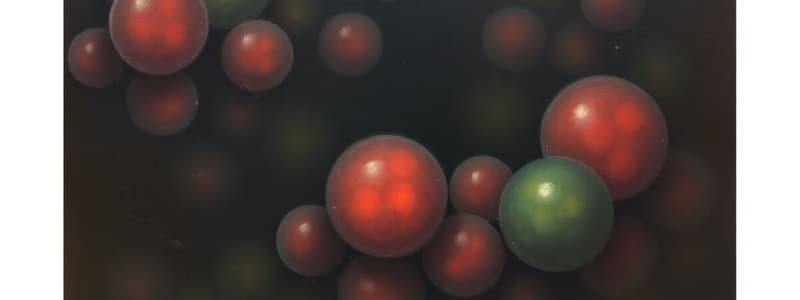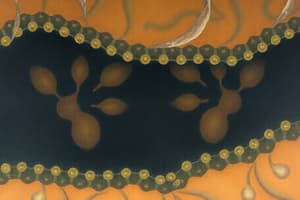Podcast
Questions and Answers
Which of the following cellular processes is most directly maintained by the plasma membrane's selective permeability?
Which of the following cellular processes is most directly maintained by the plasma membrane's selective permeability?
- DNA replication
- Protein synthesis
- Homeostasis (correct)
- Cellular respiration
If a scientist punctures a cell membrane, which of the following components would be the first to interact with the external environment?
If a scientist punctures a cell membrane, which of the following components would be the first to interact with the external environment?
- The cholesterol molecules embedded in the membrane
- The proteins spanning the membrane
- The hydrophilic heads of the phospholipid bilayer (correct)
- The hydrophobic tails of the phospholipid bilayer
A researcher discovers a new unicellular organism. Analysis reveals its plasma membrane contains a higher-than-usual concentration of cholesterol. What environmental condition might this organism most likely thrive in?
A researcher discovers a new unicellular organism. Analysis reveals its plasma membrane contains a higher-than-usual concentration of cholesterol. What environmental condition might this organism most likely thrive in?
- Extremely hot environments
- Extremely cold environments (correct)
- Environments with limited access to nutrients
- Environments with high concentrations of salts.
Why is the fluid mosaic model the accepted model for the structure of the cell membrane?
Why is the fluid mosaic model the accepted model for the structure of the cell membrane?
A cell membrane is permeable to oxygen ($O_2$) but not to glucose. What property of the cell membrane is responsible for this selective permeability?
A cell membrane is permeable to oxygen ($O_2$) but not to glucose. What property of the cell membrane is responsible for this selective permeability?
Which of the following best describes the arrangement of phospholipids in the plasma membrane?
Which of the following best describes the arrangement of phospholipids in the plasma membrane?
A certain toxin disrupts the function of proteins embedded in the cell membrane. What is the most likely consequence of this disruption?
A certain toxin disrupts the function of proteins embedded in the cell membrane. What is the most likely consequence of this disruption?
What characteristic of a molecule would allow it to pass directly through the phospholipid bilayer of a plasma membrane without the assistance of a transport protein?
What characteristic of a molecule would allow it to pass directly through the phospholipid bilayer of a plasma membrane without the assistance of a transport protein?
Flashcards
Homeostasis
Homeostasis
Balanced internal condition of cells (equilibrium). Maintained by the plasma membrane.
Plasma Membrane Functions
Plasma Membrane Functions
Protective barrier; regulates transport; allows cell recognition; provides anchoring.
Membrane Components
Membrane Components
The cell membrane is composed of phospholipids, proteins, and cholesterol.
Phospholipids
Phospholipids
Signup and view all the flashcards
Fluid Mosaic Model
Fluid Mosaic Model
Signup and view all the flashcards
Hydrophilic/Hydrophobic Regions
Hydrophilic/Hydrophobic Regions
Signup and view all the flashcards
Lipid Bilayer
Lipid Bilayer
Signup and view all the flashcards
Semipermeable Membrane
Semipermeable Membrane
Signup and view all the flashcards
Study Notes
- A Plasma Membrane is the gateway to the cell
- The Plasma Membrane is portrayed in a photograph of a cell membrane
Cell Membrane
- The cell membrane is flexible
- The cell membrane allows a unicellular organism to move
Homeostasis
- Homeostasis is a balanced internal condition of cells
- Homeostasis is also called equilibrium
- Homeostasis is maintained by the plasma membrane controlling what enters and leaves the cell
Functions of Plasma Membrane
- Plasma Membrane provides a protective barrier for the cell
- It plays an important role in regulating transport in and out of cell (selectively permeable)
- Proteins on the cell membrane allow cell recognition
- It provides anchoring sites for filaments of the cytoskeleton
Structure of the Cell Membrane
- The cell membrane consists of protein molecules, carbohydrate chains, protein channels, and lipids (bilayer)
Membrane Components
- The membrane consists of phospholipids, cholesterol, proteins, glycocalyx, and cytoskeleton and peripheral/ integral proteins
Phospholipids
- Phospholipids make up the cell membrane
- They contain 2 fatty acid chains that are nonpolar
- The head of a phospholipid is polar and contains a phosphate group
Fluid Mosaic Model
- The cell membrane is described as a "fluid mosaic model"
- Fluid because individual phospholipids and proteins can move around freely within the layer, like it's a liquid
- Mosaic because of the pattern produced by the scattered protein molecules when the membrane is viewed from above
Cell Membrane Properties
- Polar heads are hydrophilic, meaning "water loving"
- Nonpolar tails are hydrophobic, meaning "water fearing"
- These make the membrane "Selective"
Cell Membrane Composition
- The cell membrane consists of 2 layers of phospholipids called the lipid bilayer
- Hydrophobic molecules pass easily
- Hydrophilic do not pass easily
Solubility
- Materials that are soluble in lipids can pass through the cell membrane easily
Cholesterol
- Cholesterol is only present in animal cells
- Cholesterol stabilizes the membrane by reducing membrane fluidity and permeability to some smaller solutes
Semipermeable Membrane
- Small non-charged molecules move through easily
- Examples: O2 and CO2
- Ions, and large molecules such as glucose and amino acids do not move through the membrane on their own, they must use transport proteins
Assignment
- This assignment requires a hand drawn diagram of the cell membrane
- Should be on physical paper, A4 or A3 in size
- Includes all of the parts, structures and terms
- Labels and annotations are required
Studying That Suits You
Use AI to generate personalized quizzes and flashcards to suit your learning preferences.




